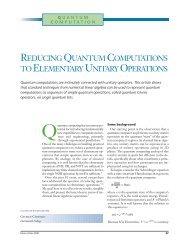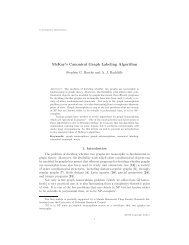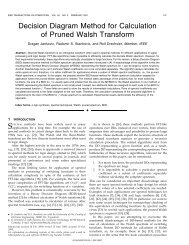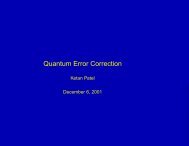pdf [1 slide per]
pdf [1 slide per]
pdf [1 slide per]
- No tags were found...
You also want an ePaper? Increase the reach of your titles
YUMPU automatically turns print PDFs into web optimized ePapers that Google loves.
The Hidden Subgroup ProblemKetan PatelMay 13, 2002
Outline• Preliminaries• Simon’s Problem• Integer Factoring / Order Finding• Hidden Subgroup Problem• Generalized Fourier Transform• Non-Abelian Groups .
Groups• Group (G,+): closure, associativity, identity, inverses• Abelian Group: group satisfying commutativity• Subgroup K of G: subset of G forming a group• Coset of K: translation of a subgroup KExamples of groups:(Z n ,+) additive group of integers mod n(R,∗) multiplicative group of nonzero real numbers(B n ,+) additive group of binary n-tuples (+ ≡ bitwise ⊕)(S n ,∗) group of <strong>per</strong>mutations on n elements (∗≡composition)
Hadamard Transform1-qubit Hadamard|0〉 + |1〉H (α|0〉 + β|1〉)=α √ + β |0〉−|1〉 √2 2Applying Hadamard to n qubits individuallyH n |x〉 = 1 √2n ∑y(−1) x·y |y〉Note: H n |0〉 gives equal su<strong>per</strong>position of all basis states
Quantum Fourier Transformn-qubit Quantum Fourier Transform (N = 2 n )∑|x〉→√ 1 N−1exp 2πixk/N |k〉Nk=0
Given: function f : B n → B nSimon’s Problemf (x)= f (y) iff x ⊕ y = β for all x, y ∈ B nf has “<strong>per</strong>iodicity” βGoal: Determine β efficiently
Simon’s AlgorithmStep 0) Prepare 2n qubits in |0〉 stateStep 1) Create su<strong>per</strong>position of allbasis states in first n qubitsStep 2) Apply U f∑x|x〉|0〉→∑x|x〉|f (x)〉| 0| 0| 0| 0| 0| 0| 0| 0H nxyU fxy f(x)|x0 + |x0 β|f(x0)Step 3) Measure last n qubits∑|x〉|f (x)〉 → (|x 0 〉 + |x 0 ⊕ β〉) ⊗ |f (xx} {{ }0 )〉state of 1st n qubitsMeasuring 1st n qubits yields no information about β
Simon’s Algorithm (cont.)Step 4) Apply Hadamard Transform to first n qubits|x 0 〉 + |x 0 ⊕ β〉 → ∑y((−1) x 0·y +(−1) (x 0⊕β)·y ) |y〉= ∑ (−1) x 0·y |y〉y: y·β=0⇐ x0 only affects phaseStep 5) Measure first n qubits and get y i such that y i · β = 0Step 6) Repeat enough times (O(n 2 )) to get system of equations⎡⎤ ⎡ ⎤y 0 (1) y 0 (2) ··· y 0 (n) β(1)⎢ y 1 (1) y 1 (2) ··· y 1 (n)⎥⎣ ... ... ... ⎦ ·⎢ β(2)⎥⎣ ... ⎦ = 0y k (1) y k (2) ··· y k (n) β(n)Step 7) Solve for β
Integer FactoringInteger factoring can be mapped to order findingProblem: Find factor of N ⇒ Problem: Find least integer r such thaty r ≡ 1(mod N)Step 0) Select integer a < N at randomStep 1) Use Euclid’s algorithm to compute gcd(a,N)Step 2) If > 1 doneStep 3) Otherwise use order finding algorithm to find least r fora r ≡ 1 (mod N)Step 4) If r is odd or a r/2 ≡−1 (mod N) startoverStep 5) Calculate α and β:( )()a r − 1 = a r/2 − 1 a r/2 + 1 ≡ 0 (mod N)} {{ }} {{ }α βStep 6) If N|α or N|β start overStep 7) Compute gcd(N,α) and gcd(N,β)
Order Finding AlgorithmStep 0) Prepare t + ⌈log 2 N⌉ qubits in |0〉 state (Let T = 2 t )Step 1) Create uniform su<strong>per</strong>position on first t qubitsStep 2) Apply U f∑x|x〉|0〉→∑x|x〉|y x mod N〉Step 3) Measure second register∑|x〉|y x 〉→∑|x 0 + λr〉|y x 0〉x λStep 4) Apply Discrete Fourier Transform to first register∑λ|x 0 + λr〉 → ∑l= ∑l≈∑exp 2πil(x0+λr)/T |l〉λ{ ≈0 if }} lr≠kT {exp 2πilx0/T |l〉 exp 2πilλr/T∑exp 2πikx 0/rk∣kTr∑λ〉
Order Finding Algorithm (cont.)Step 5) Measure first register and get c = k(T /r)Step 6) Use continued fraction algorithm to retrieve r
Hidden Subgroup ProblemSuppose• K is a subgroup of a group G• f : g → x function from G to discreteset X• f (g 1 )= f (g 2 ) ⇔ g 2 ∈ g 1 + KK+K+K+Kc m−1c m−2c 1x m−1x m−2x 1x0GfXProblem: Find generating set for KExample (Simon’s Problem): K = {0,β}
More Group TheoryRepresentation ρ(G): Mapping from G ⇒ group of complex matricespreserving group pro<strong>per</strong>ties (homomorphism)e.g. ρ(g i )ρ(g j )=ρ(g i + g j )Irreducible Representation ρ: ρ cannot be written as ρ 1 ⊕ ρ 2Blank Example: The irreducible representations of Z 4ρ(0) ρ(1) ρ(2) ρ(3)ρ 1 1 1 1 1 ⇐ trivial representationρ 2 1 −i −1 iρ 3 1 −1 1 −1ρ 4 1 i −1 −iCharacter χ(ρ): Mapping defined by g i → trace(ρ(g i ))For Abelian groups irr. representations are 1-D ⇒ irreducible χ(ρ)=ρ
Fourier Transform over GFourier Transform: Transformation from standard basis of group elementsto basis of irreducible characters of GPro<strong>per</strong>ties:• subgroup K FT → K ⊥ := {χ : χ(k)=1 for all k ∈ K}K =χ∈K ⊥ ker χ• shift invariance∑ |g + k〉 FT →= ∑ χ(g)|χ〉k∈Kχ∈K ⊥
General HSP AlgorithmStep 1) Create uniform su<strong>per</strong>position of states in coset of KStep 2) Apply Fourier Transform over GStep 3) Sample distribution χ i ∈ K ⊥Step 4) Reconstruct (classically) K = ∩ ker χ i
General Issues• Constructing initial su<strong>per</strong>position may be nontrivial• Efficient FT over group may not be known• Group may not be known (e.g., factoring)
Issues for Non-Abelian case:Non-Abelian Groups• Non-unique Fourier Transform• Efficient implementation of FT• Determining subgroup from sampling of FT• In general no shift-invariant basis
Graph IsomorphismLet M A , M B be the incidence matrices of graphs A and BA ≃ B if P(M A )=M B for some <strong>per</strong>mutation matrix PProblem: Given A and B determine if A ≃ BFormulate as Non-abelian HSP:• Let C = A ∪ B, L A = {vertices of A} and L B = {vertices of B}• Automorphism group of C, K is a subgroup of S 2n• If A ≄ B all k ∈ K will map L Ak → LAotherwise half of K will map L A → L B• Therefore sampling K will determine if A ≃ BUnfortunately generating su<strong>per</strong>position of elements of K nontrivial
Results for Non-Abelian Case• Solved for normal subgroup assuming efficient FT (Hallgren et al. 2000)• Solvable if ∩ normalizers of all subgroups is large (Grigni et al. 2000)• “Solved” for dihedral groups — need exponential post-processing(Ettinger and Høyer 2000)• Solved for groups formed by certain wreath products(Rötteler & Beth 1998)• Efficient FT over S n known (Beals 1997)
References• Jozsa - Quantum Factoring, Discrete Logarithms, and the Hidden SubgroupProblem (2000)quant-ph/0012084• Jozsa - Quantum Algorithms and the Fourier Transform (1997)quant-ph/9707033• Hallgren & Russell - The Hidden Subgroup Problem and QuantumComputation Using Group Representations (2001)www.cs.caltech.edu/ hallgren/reps1.<strong>pdf</strong>• Hallgren - Quantum Fourier Sampling, the Hidden Subgroup Problem,and Beyond (2000)www.cs.caltech.edu/ hallgren/thesis.<strong>pdf</strong>


![pdf [1 slide per]](https://img.yumpu.com/44496330/1/500x640/pdf-1-slide-per.jpg)





